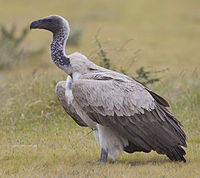
Photo from wikipedia
Vultures constitute an important functional group in many ecosystems, providing crucial ecosystem services both in natural and humanized environments. These scavengers are facing massive declines worldwide, but in several African… Click to show full abstract
Vultures constitute an important functional group in many ecosystems, providing crucial ecosystem services both in natural and humanized environments. These scavengers are facing massive declines worldwide, but in several African countries virtually nothing is known on populations’ status and threats, hampering the development of adequate conservation strategies. In Guinea-Bissau, globally important populations of Hooded Necrosyrtes monachus and African white-backed vultures Gyps africanus were recently reported. Using the country as a study area, we aim to characterize human-vulture interactions in West Africa applying a multidisciplinary approach. We assessed the status and distribution of vulture populations using data from 1711 km of roadside transects, examined predictors of their distribution, and produced a nationwide population estimate for the Hooded Vulture, using an innovative method based on the relationship between the size of human population in settlements and vulture numbers. We conducted 47 stakeholder interviews to assess perceived roles played by vultures, and to investigate potential anthropogenic threats. Hooded vultures were strongly associated with high human population densities, whereas no relation was found between African white-backed and Rüppell’s vultures and any of the tested predictors, which included cattle density, precipitation and Normalized Difference Vegetation Index, among others. We estimate a national population of 43347 Hooded vultures, the largest population reported in the species range. Respondents were generally aware of the services provided by vultures, especially waste and carcass removal, including in urban areas. Hunting for witchcraft and traditional medicine was the most frequently recognised threat, while poisoning was ranked as having the highest impact. We hypothesise that poisoning-related mortality may be affecting African white-backed and Rüppell’s vultures’ distribution and explain their scarcity in apparently highly suitable habitats. Our results suggest a mutualistic rather than a commensalistic relationship between vultures and humans, with important implications for designing and implementing conservation strategies.
Journal Title: PLoS ONE
Year Published: 2018
Link to full text (if available)
Share on Social Media: Sign Up to like & get
recommendations!